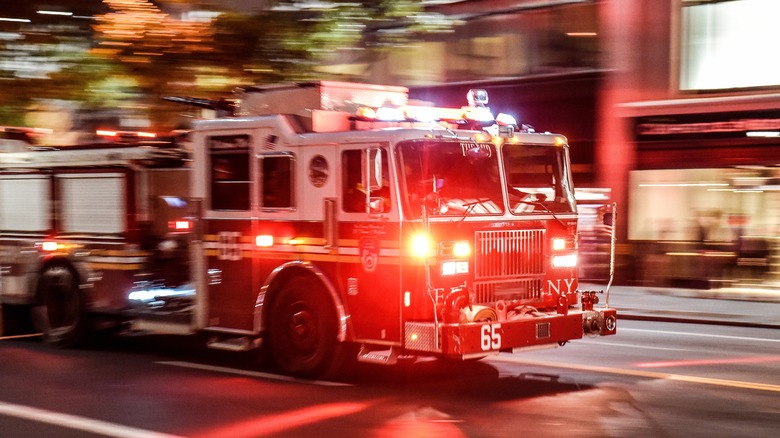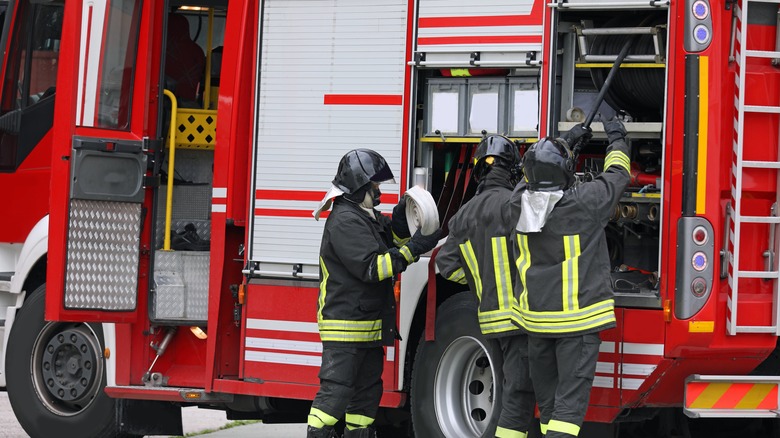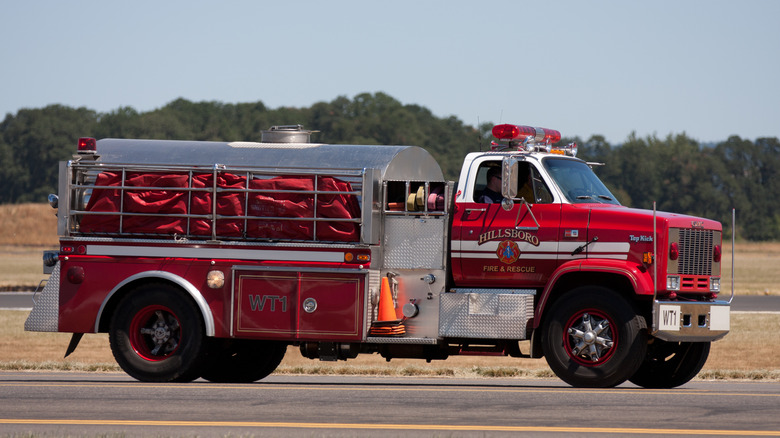Fire Truck Vs. Water Truck: What's The Difference?
The work of a firefighter would no doubt be deemed heroic by the bulk of the world's population — even if many would also deem it a little too dangerous to undertake themselves. The job does, after all, involve dashing headlong into life-threatening situations, and as the job title denotes, that often means fighting entails fires.
Whether you're brave enough to fight fires yourself or not, we'd wager that you still get a thrill, or, perhaps, a pang of anxiety, whenever you see, or hear a fire truck honk three times while barreling down the road en route to help a citizen in need or a building ablaze. Lights and sirens are only one small part of what makes a fire truck unique among the various emergency response vehicles one might see. The massive, boxy emergency vehicles are also outfitted with all manners of fire fighting equipment, which often includes building-scaling ladders and hoses to pump water from both onboard supplies and fire hydrants.
You may not realize it, but there are actually several different types of fire trucks on the streets these days. To that end, it's likely that many of you don't realize the term "fire truck" shouldn't be used as a blanket name for all emergency fire vehicles, as the different variants of vehicles employed by fire fighters are designed for different purposes. That list includes fire trucks and water trucks, who's jobs are more different than you might know.
Why is a fire truck called a 'fire truck' and not a water truck?
As we're set to drill down and expose the differences between a fire truck and a water truck, we should, perhaps, first acknowledge that there are different variations of fire trucks themselves. The three primary variants are aerial trucks, fire engines, and standard fire trucks. The first of those vehicles is probably the version of fire truck that typically comes to mind when we think about fire trucks, as they have ladders on top that grant firefighters access to upper levels of buildings as well as rooftops. The second variant are sometimes referred to as pumper trucks, as they typically carry their own water supply, along with the hoses and pumps needed to disperse it.
Fire engines tend to be the first trucks to arrive on the scene of a fire emergency, as their onboard water supplies allow them to suppress a fire until vehicles arrive that can connect to a water supply like a hydrant. Yes, many fire engines also have ladders affixed to the top to aid in their suppressing efforts, meaning pumper trucks and aerial trucks are sometimes one and the same.
If you're wondering why these emergency vehicles are not typically referred to as water trucks, it's because their primary goal is directly fighting fires. On the other hand, fire trucks in the most general sense of the term are largely designed to carry extra tools — including axes, ladders, and potentially those oddly-shaped helmets – and personnel to the scene of an emergency. For the most part, these particular trucks do not carry water at all.
So what is a water truck anyway?
With that information in hand, the question becomes why there's a separate designation for a water truck. The answer really is quite simple, in that the sole purpose of a water truck is the transportation of water to the scene of an emergency to be used by another fire fighting apparatus. In general, water trucks do not carry additional equipment to the scene of an emergency and are not typically equipped to disperse the water over a fire themselves. They may, however, carry additional lengths of hose on board should the need arise on the scene.
Water trucks are sometimes called tankers or water tenders due to their seemingly singular purpose in the fire fighting arena. As for how much water these vehicles can transport to the scene of an emergency, the goal of a water truck is to show up with as much H20 as possible, with some capable of ferrying anywhere between 1,500 to 5,000 gallons of water at a time.
Given their primary function, water trucks are not typically used by firehouses in urban landscapes where fire hydrants and other water sources are more easily accessible. Rather, they are more common in rural locales where water supplies are scarce or even non-existent. Likewise, they are sometimes employed alongside fire fighting helicopters and aircraft to help contain wildfires spreading in hard to reach areas. In those instances, a dedicated water truck could indeed be the difference between a fire being kept in check or running dangerously amok.


